Air RENAULT KOLEOS 2012 1.G Owners Manual
[x] Cancel search | Manufacturer: RENAULT, Model Year: 2012, Model line: KOLEOS, Model: RENAULT KOLEOS 2012 1.GPages: 233, PDF Size: 7.81 MB
Page 5 of 233

0.3
ENG_UD10779_7
Sommaire Général (X06 - C06 - S06 - X35 - L35 - X44 - C44 - G44 - X45 - H45 - X65 - L65 - S65 - X73 - B73 - X74 - B74 - K74 - X77 - J77 - F77 - R77 - X81 - J81 - X84 -
ENG_NU_977-2_H45_Ph2_Renault_0
Getting to know your vehicle ...............................
Driving
...................................................................
Your comfort .........................................................
Maintenance .........................................................
Practical advice ....................................................
Technical specifications ......................................
Alphabetical index ...............................................
Sections
1
C O N T E N T S
2
3
4
5
6
7
Page 7 of 233
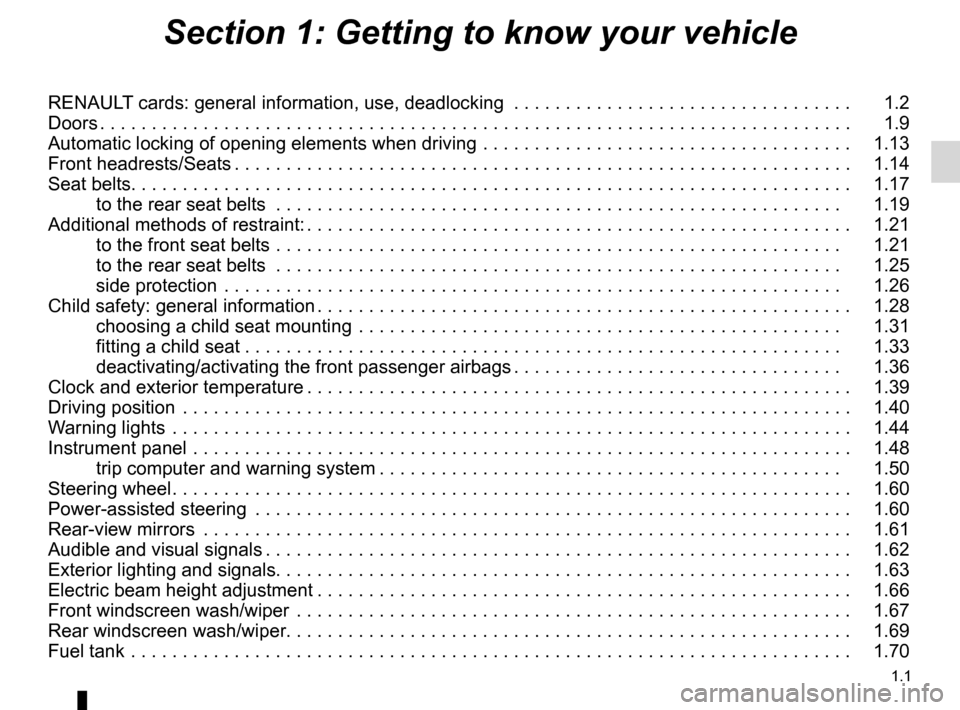
1.1
ENG_UD27163_2
Contents 1 (X45 - H45 - Renault)
ENG_NU_977-2_H45_Ph2_Renault_1
Section 1: Getting to know your vehicle
RENAULT cards: general information, use, deadlocking . . . . . . . . . . . . . . . . . . . . . . . . . . . . . . . . . 1.2
Doors . . . . . . . . . . . . . . . . . . . . . . . . . . . . . . . . . . . . . . . . . . . . . . . . . . . . . . . . . . . . . . . . . . . . . . . . . 1.9
Automatic locking of opening elements when driving . . . . . . . . . . . . . . . . . . . . . . . . . . . . . . . . . . . . 1.13
Front headrests/Seats . . . . . . . . . . . . . . . . . . . . . . . . . . . . . . . . . . . . . . . . . . . . . . . . . . . . . . . . . . . . 1.14
Seat belts . . . . . . . . . . . . . . . . . . . . . . . . . . . . . . . . . . . . . . . . . . . . . . . . . . . . . . . . . . . . . . . . . . . . . . 1.17
to the rear seat belts . . . . . . . . . . . . . . . . . . . . . . . . . . . . . . . . . . . . . . . . . . . . . . . . . . . . . . . 1.19
Additional methods of restraint: . . . . . . . . . . . . . . . . . . . . . . . . . . . . . . . . . . . . . . . . . . . . . . . . . . . . . 1.21
to the front seat belts . . . . . . . . . . . . . . . . . . . . . . . . . . . . . . . . . . . . . . . . . . . . . . . . . . . . . . . 1.21
to the rear seat belts . . . . . . . . . . . . . . . . . . . . . . . . . . . . . . . . . . . . . . . . . . . . . . . . . . . . . . . 1.25
side protection . . . . . . . . . . . . . . . . . . . . . . . . . . . . . . . . . . . . . . . . . . . . . . . . . . . . . . . . . . . . 1.26
Child safety: general information . . . . . . . . . . . . . . . . . . . . . . . . . . . . . . . . . . . . . . . . . . . . . . . . . . . . 1.28
choosing a child seat mounting . . . . . . . . . . . . . . . . . . . . . . . . . . . . . . . . . . . . . . . . . . . . . . . 1.31
fitting a child seat . . . . . . . . . . . . . . . . . . . . . . . . . . . . . . . . . . . . . . . . . . . . . . . . . . . . . . . . . . 1.33
deactivating/activating the front passenger airbags . . . . . . . . . . . . . . . . . . . . . . . . . . . . . . . . 1.36
Clock and exterior temperature . . . . . . . . . . . . . . . . . . . . . . . . . . . . . . . . . . . . . . . . . . . . . . . . . . . . . 1.39
Driving position . . . . . . . . . . . . . . . . . . . . . . . . . . . . . . . . . . . . . . . . . . . . . . . . . . . . . . . . . . . . . . . . . 1.40
Warning lights . . . . . . . . . . . . . . . . . . . . . . . . . . . . . . . . . . . . . . . . . . . . . . . . . . . . . . . . . . . . . . . . . . 1.44
Instrument panel . . . . . . . . . . . . . . . . . . . . . . . . . . . . . . . . . . . . . . . . . . . . . . . . . . . . . . . . . . . . . . . . 1.48
trip computer and warning system . . . . . . . . . . . . . . . . . . . . . . . . . . . . . . . . . . . . . . . . . . . . . 1.50
Steering wheel . . . . . . . . . . . . . . . . . . . . . . . . . . . . . . . . . . . . . . . . . . . . . . . . . . . . . . . . . . . . . . . . . . 1.60
Power-assisted steering . . . . . . . . . . . . . . . . . . . . . . . . . . . . . . . . . . . . . . . . . . . . . . . . . . . . . . . . . . 1.60
Rear-view mirrors . . . . . . . . . . . . . . . . . . . . . . . . . . . . . . . . . . . . . . . . . . . . . . . . . . . . . . . . . . . . . . . 1.61
Audible and visual signals . . . . . . . . . . . . . . . . . . . . . . . . . . . . . . . . . . . . . . . . . . . . . . . . . . . . . . . . . 1.62
Exterior lighting and signals . . . . . . . . . . . . . . . . . . . . . . . . . . . . . . . . . . . . . . . . . . . . . . . . . . . . . . . . 1.63
Electric beam height adjustment . . . . . . . . . . . . . . . . . . . . . . . . . . . . . . . . . . . . . . . . . . . . . . . . . . . . 1.66
Front windscreen wash/wiper . . . . . . . . . . . . . . . . . . . . . . . . . . . . . . . . . . . . . . . . . . . . . . . . . . . . . . 1.67
Rear windscreen wash/wiper . . . . . . . . . . . . . . . . . . . . . . . . . . . . . . . . . . . . . . . . . . . . . . . . . . . . . . . 1.69
Fuel tank . . . . . . . . . . . . . . . . . . . . . . . . . . . . . . . . . . . . . . . . . . . . . . . . . . . . . . . . . . . . . . . . . . . . . . 1.70
Page 22 of 233

1.16
ENG_UD27217_3
Si ges avant (X45 - H45 - Renault)
ENG_NU_977-2_H45_Ph2_Renault_1
fRONT sEATs (2/2)
To fold down the passenger seat
Depending on the vehicle, the passen-
ger seatback may be folded down onto
the seat base to create a table.
Lift handle 6 and lower the seatback.
6
heated seats(depending on vehicle)
W i t h t h e e n g i n e r u n n i n g , p r e s s
switch 8 , pressing on the top of the
switch (to select the warmest setting) or
the bottom of the switch (to select the
average setting).
The indicator light on the button lights
up.
The system, which has a thermostat,
decides whether or not the heating is
needed, according to the position se -
lected.
If the heated front passenger seat is ac-
tivated, the indicator light
ð lights
up on the instrument panel.
78
Since front passenger airbag operation and the position of a front pas-
senger seatback table are incompatible, ensure that the airbag is deac-
tivated. (Refer to the information on “Front passenger air bag activation/
deactivation” in Section 1).
There is a risk of very serious injury if the air bags deploy.
When driving, rear passengers must not place their feet on the seatback of the
front seats under any circumstances. Risk of injury.
To adjust the lumbar support on the
driver’s seat:
Move lever 7.
Page 27 of 233

seat belts .............................................. (up to the end of the DU)
additional methods of restraint to the front seat belts ......................(up to the end of the DU)
seat belt pretensioners front seat belt .................................. (up to the end of the DU)
air bag ................................................... (up to the end of the DU)
1.21
ENG_UD23486_3
Dispositifs complémentaires à la ceinture avant (X45 - H45 - Renault)
ENG_NU_977-2_H45_Ph2_Renault_1
Additional methods of restraint:
to the front seat belts
METhOds Of REsTRAINT IN AddITION TO ThE fRONT sEAT BELTs (1/4)
Depending on the vehicle, they are
composed of:
– seat belt inertia reel pretension -
ers 1;
– lap belt pretensioner 2;
– air bags for driver and front pas -
senger 3.
These systems are designed to act in-
dependently or together when the vehi-
cle is subjected to a frontal impact.
The following systems will be triggered
according to the level of impact force:
– seat belt locking;
– the seat belt inertia reel pretensioner
(which engages to correct seat belt
slack);
– the lap seat belt pretensioners to
hold the occupant in his seat;
– the front air bag.
pretensioners
The pretensioners flatten the belt
against the body, holding the occupant
against the seat, thus improving the ef-
ficiency of the belt.
In the event of a severe frontal impact
and if the ignition is switched on, the
system may engage the following de -
pending on the force of the impact:
– the seat belt inertia reel preten -
sioner 1 which instantly retracts the
seat belt;
– the lap belt pretensioner 2 which in-
stantly retracts the lap belt.
– Have the entire restraint
system checked following
an accident.
– No operation whatso -
ever is permitted on any part of
the system (pretensioners, air
bags, computers, wiring) and the
system components must not
be reused on any other vehicle,
even if identical.
– To avoid incorrect triggering of
the system which may cause
injury, only qualified personnel
from an approved dealer may
work on the pretensioner and air
bag system.
– The ignition module electrical
specifications may only be tested
by a specially trained technician
using special equipment.
– When the vehicle is scrapped,
contact an approved dealer for
disposal of the pretensioner and
air bag gas generators.
1
2
3
Page 28 of 233
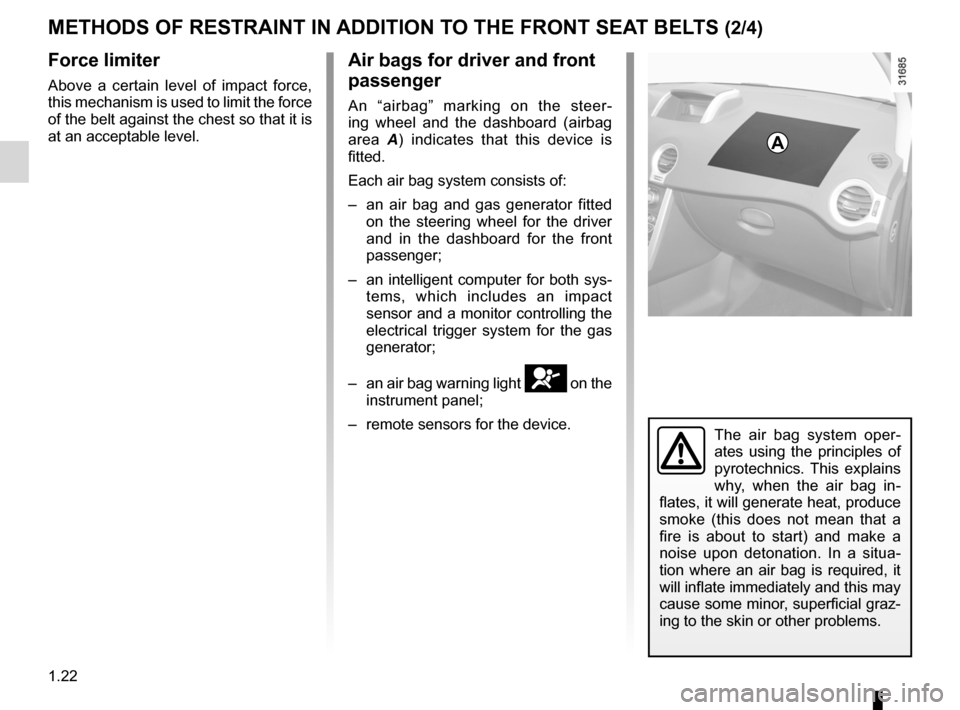
1.22
ENG_UD23486_3
Dispositifs complémentaires à la ceinture avant (X45 - H45 - Renault)
ENG_NU_977-2_H45_Ph2_Renault_1
Jaune NoirNoir texte
METhOds Of REsTRAINT IN AddITION TO ThE fRONT sEAT BELTs (2/4)
force limiter
Above a certain level of impact force,
this mechanism is used to limit the force
of the belt against the chest so that it is
at an acceptable level.
Air bags for driver and front
passenger
An “airbag” marking on the steer -
ing wheel and the dashboard (airbag
area A ) indicates that this device is
fitted.
Each air bag system consists of:
– an air bag and gas generator fitted
on the steering wheel for the driver
and in the dashboard for the front
passenger;
– an intelligent computer for both sys-
tems, which includes an impact
sensor and a monitor controlling the
electrical trigger system for the gas
generator;
– an air bag warning light
å on the
instrument panel;
– remote sensors for the device.
The air bag system oper -
ates using the principles of
pyrotechnics. This explains
why, when the air bag in -
flates, it will generate heat, produce
smoke (this does not mean that a
fire is about to start) and make a
noise upon detonation. In a situa -
tion where an air bag is required, it
will inflate immediately and this may
cause some minor, superficial graz-
ing to the skin or other problems.
A
Page 29 of 233
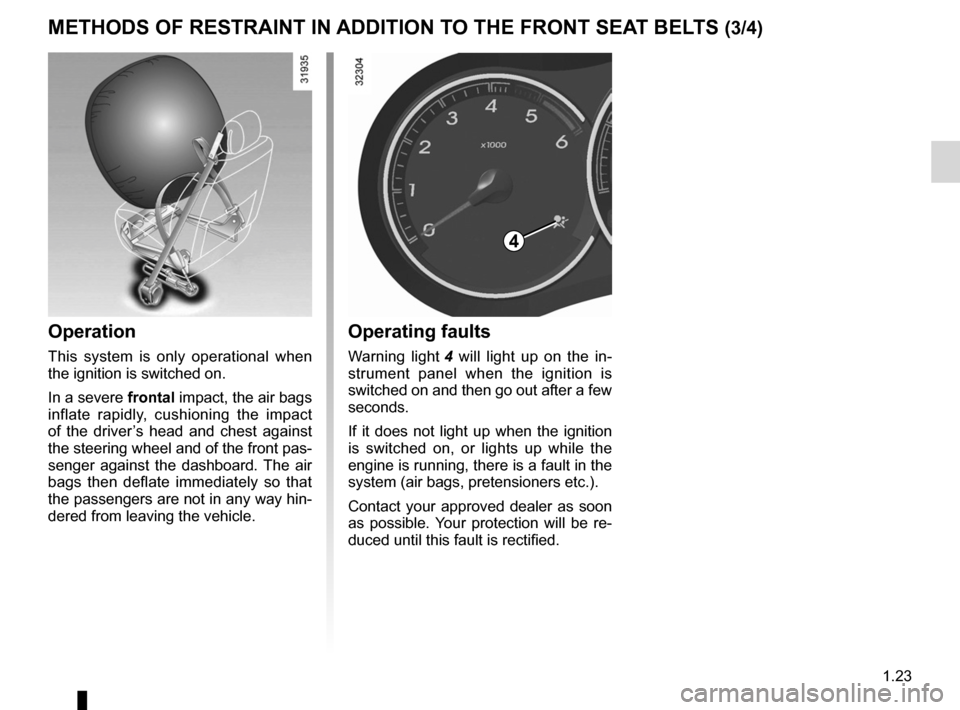
JauneNoirNoir texte
1.23
ENG_UD23486_3
Dispositifs complémentaires à la ceinture avant (X45 - H45 - Renault)
ENG_NU_977-2_H45_Ph2_Renault_1
METhOds Of REsTRAINT IN AddITION TO ThE fRONT sEAT BELTs (3/4)
Operation
This system is only operational when
the ignition is switched on.
In a severe frontal impact, the air bags
inflate rapidly, cushioning the impact
of the driver’s head and chest against
the steering wheel and of the front pas-
senger against the dashboard. The air
bags then deflate immediately so that
the passengers are not in any way hin-
dered from leaving the vehicle.
Operating faults
Warning light 4 will light up on the in -
strument panel when the ignition is
switched on and then go out after a few
seconds.
If it does not light up when the ignition
is switched on, or lights up while the
engine is running, there is a fault in the
system (air bags, pretensioners etc.).
Contact your approved dealer as soon
as possible. Your protection will be re-
duced until this fault is rectified.
4
Page 30 of 233
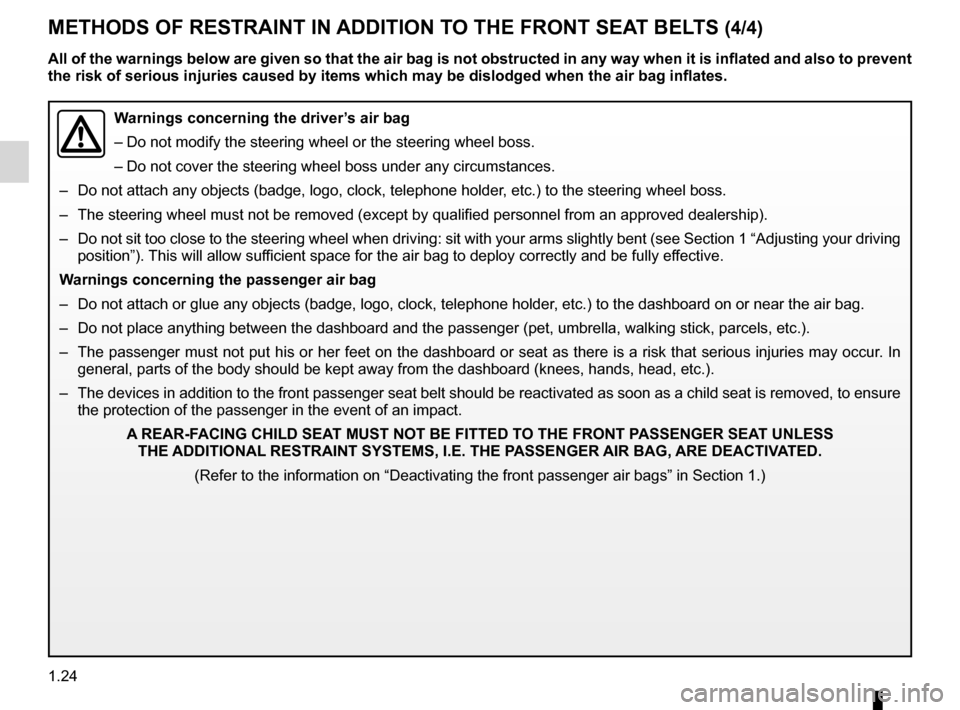
1.24
ENG_UD23486_3
Dispositifs complémentaires à la ceinture avant (X45 - H45 - Renault)
ENG_NU_977-2_H45_Ph2_Renault_1
METhOds Of REsTRAINT IN AddITION TO ThE fRONT sEAT BELTs (4/4)
All of the warnings below are given so that the air bag is not obstructed in any way when it is inflated and also to prevent
the risk of serious injuries caused by items which may be dislodged when the air bag inflates.
Warnings concerning the driver’s air bag
– Do not modify the steering wheel or the steering wheel boss.
– Do not cover the steering wheel boss under any circumstances.
– Do not attach any objects (badge, logo, clock, telephone holder, etc.) to the steering wheel boss.
– The steering wheel must not be removed (except by qualified personnel from an approved dealership).
– Do not sit too close to the steering wheel when driving: sit with your arms slightly bent (see Section 1 “Adjusting your driving
position”). This will allow sufficient space for the air bag to deploy correctly and be fully effective.
Warnings concerning the passenger air bag
– Do not attach or glue any objects (badge, logo, clock, telephone holder, etc.) to the dashboard on or near the air bag.
– Do not place anything between the dashboard and the passenger (pet, umbrella, walking stick, parcels, etc.).
– The passenger must not put his or her feet on the dashboard or seat as there is a risk that serious injuries may occur. In
general, parts of the body should be kept away from the dashboard (knees, hands, head, etc.).
– The devices in addition to the front passenger seat belt should be reactivated as soon as a child seat is removed, to ensure
the protection of the passenger in the event of an impact.
A REAR-f AcINg chILd sEAT MUsT NOT BE fITTEd TO ThE fRONT p AssENgER sEAT UNLEss
ThE AddITIONAL REsTRAINT sYsTEMs, I.E. ThE p AssENgER AIR BAg, ARE dEAcTIvATEd.
(Refer to the information on “Deactivating the front passenger air bags” in Section 1.)
Page 31 of 233

additional methods of restraintto the rear seat belts .......................(up to the end of the DU)
methods of restraint in addition to the seat belts
(up to the end of the DU)
air bag ................................................... (up to the end of the DU)
1.25
ENG_UD20768_2
Dispositifs complémentaires aux ceintures arrière (X45 - H45 - Renault)
ENG_NU_977-2_H45_Ph2_Renault_1
to the rear seat belts
METhOds Of REsTRAINT IN AddITION TO ThE REAR sEAT BELTs
force limiter
Above a certain level of impact force,
this mechanism is used to limit the force
of the belt against the chest so that it is
at an acceptable level.
– Have the entire restraint system checked following an accident.
– No operation whatsoever is permitted on any part of the system (pre-
tensioners, air bags, computers, wiring) and the system components
must not be reused on any other vehicle, even if identical.
– To avoid incorrect triggering of the system which may cause injury, only quali -
fied personnel from an approved dealer may work on the pretensioner and air
bag system.
– The ignition module electrical specifications may only be tested by a specially
trained technician using special equipment.
– When the vehicle is scrapped, contact an approved dealer for disposal of the
pretensioner and air bag gas generators.
Page 32 of 233

air bag................................................... (up to the end of the DU)
additional methods of restraint side protection ................................ (up to the end of the DU)
methods of restraint in addition to the seat belts
(up to the end of the DU)
1.26
ENG_UD20769_2
Dispositif de protection lat rale (X45 - H45 - Renault)
ENG_NU_977-2_H45_Ph2_Renault_1
side protection
sIdE pROTEcTION dEvIcEs
side air bags
This air bag is fitted to each of the front
seats and is inflated at the sides of
the seats (door side) to protect the oc-
cupants in the event of a severe side
impact.
curtain air bags
These are air bags fitted along the sides
of the vehicle in the ceiling which trigger
along the front and rear side windows
to protect the passengers in case of a
severe side impact.
Warnings concerning the side air bag
– fitting seat covers: seats equipped with an air bag require covers
specifically designed for your vehicle. Contact an approved dealer to find
out if these covers are sold at approved accessory outlets. The use of
any covers other than those designed for your vehicle (and including those de-
signed for another vehicle) may affect the operation of the air bags and reduce
your protection.
– Do not place any accessories, objects or even pets between the seatback, the
door and the internal fittings. Do not cover the seatback with any items such as
clothes or accessories. This may prevent the air bag from operating correctly
or cause injury when the air bag is deployed.
– No work or modification whatsoever may be carried out on the seat or internal
fittings, except by qualified personnel from an approved Dealer.
– These air bags operate through slits in the front seatbacks (door side): never
insert any objects in these slits.
Page 33 of 233
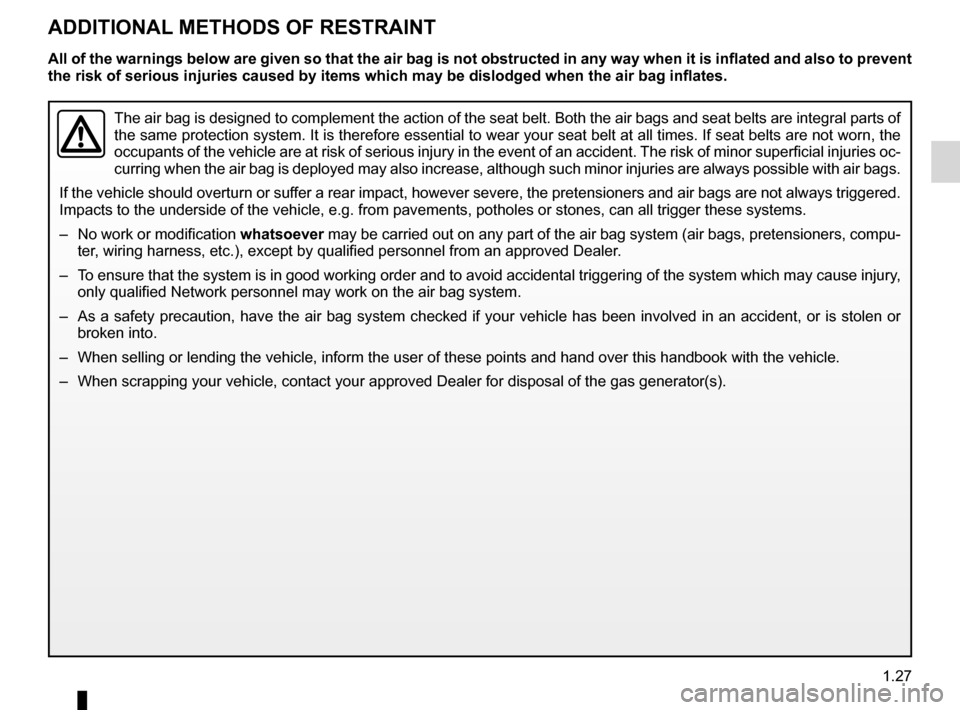
air bag................................................... (up to the end of the DU)
methods of restraint in addition to the seat belts
(up to the end of the DU)
additional methods of restraint ............. (up to the end of the DU)
1.27
ENG_UD20770_2
Dispositifs de retenue complémentaire (X45 - H45 - Renault)
ENG_NU_977-2_H45_Ph2_Renault_1
AddITIONAL METhOds Of REsTRAINT
All of the warnings below are given so that the air bag is not obstructed in any way when it is inflated and also to prevent
the risk of serious injuries caused by items which may be dislodged when the air bag inflates.
The air bag is designed to complement the action of the seat belt. Both the air bags and seat belts are integral parts of
the same protection system. It is therefore essential to wear your seat belt at all times. If seat belts are not worn, the
occupants of the vehicle are at risk of serious injury in the event of an accident. The risk of minor superficial injuries oc-
curring when the air bag is deployed may also increase, although such minor injuries are always possible with air bags.
If the vehicle should overturn or suffer a rear impact, however severe, the pretensioners and air bags are not always triggered.
Impacts to the underside of the vehicle, e.g. from pavements, potholes or stones, can all trigger these systems.
– No work or modification whatsoever may be carried out on any part of the air bag system (air bags, pretensioners, compu-
ter, wiring harness, etc.), except by qualified personnel from an approved Dealer.
– To ensure that the system is in good working order and to avoid accidental triggering of the system which may cause injury,
only qualified Network personnel may work on the air bag system.
– As a safety precaution, have the air bag system checked if your vehicle has been involved in an accident, or is stolen or
broken into.
– When selling or lending the vehicle, inform the user of these points and hand over this handbook with the vehicle.
– When scrapping your vehicle, contact your approved Dealer for disposal of the gas generator(s).